Sentinelese
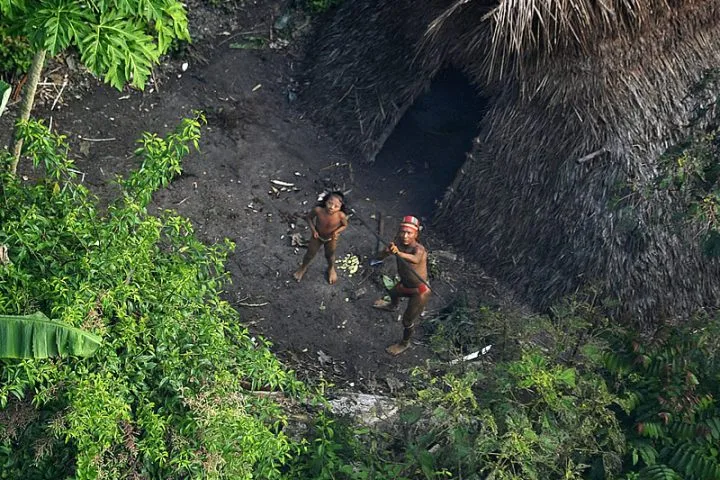
The Sentinelese people are one of the most remote and isolated tribes in the world, residing on North Sentinel Island in the Andaman Islands of India. They are estimated to have lived on the island for thousands of years and have had virtually no contact with the outside world.
Appearance: The Sentinelese people have dark skin, short stature, and athletic builds. They are known to be expert swimmers and divers, which is necessary for their survival as they rely heavily on fishing for sustenance.
Culture and Language: The culture of the Sentinelese people is largely unknown, but it is believed that they have a primitive hunter-gatherer lifestyle. Their language is also unknown, and attempts to communicate with them have been largely unsuccessful due to their hostility towards outsiders.
Religion: The religion of the Sentinelese people is not known, but it is believed that they have animistic beliefs and worship the natural world around them.
Population Size and Living Places: The population size of the Sentinelese people is estimated to be around 50-200 individuals. They live in small huts made from branches and leaves, which are scattered throughout the island.
Houses and Weapons: The houses of the Sentinelese people are made from woven bamboo and palm leaves, and are built on stilts to protect against flooding. They are known to use a variety of weapons, including bows and arrows, spears, and knives, which they make from local materials.
Recent Contacts: The Sentinelese people are fiercely protective of their isolation and have been known to attack outsiders who attempt to approach their island. The Indian government has declared the island off-limits to outsiders in order to protect the Sentinelese people from exposure to outside diseases and cultural influences. However, there have been some recent incidents where outsiders have attempted to make contact with the tribe, which has resulted in violent clashes. These incidents serve as a reminder of the importance of respecting the autonomy of isolated communities like the Sentinelese people.
Yanomami
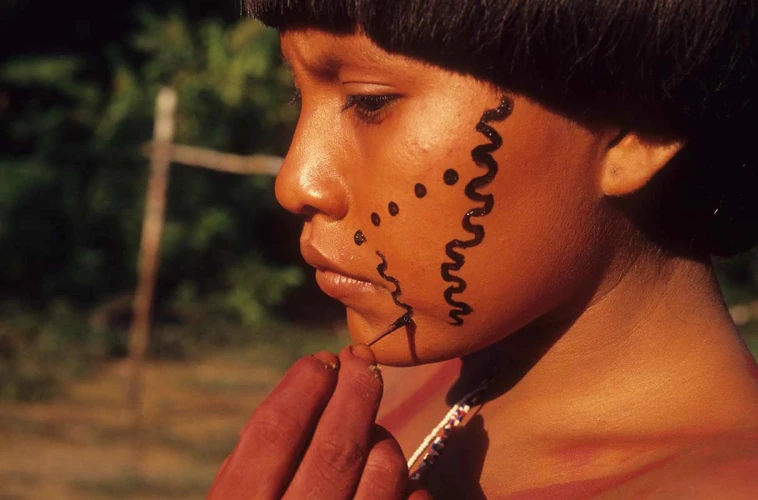
The Yanomami are a group of indigenous people who live in the Amazon rainforest along the borders of Venezuela and Brazil. They are known for their unique culture, way of life, and ongoing struggles to protect their land and rights.
Appearance The Yanomami are typically short in stature and have dark skin and straight black hair. Men and women often wear their hair long and decorate it with feathers and other adornments. Both men and women wear minimal clothing, consisting of a loincloth or skirt made of woven fibers.
Culture Yanomami culture is rich and complex. They have a unique social organization, with each village composed of several extended families. Villages are largely self-sufficient and operate independently from one another. Yanomami are a semi-nomadic people who rely on hunting, fishing, and gathering for their subsistence. They cultivate a variety of crops, including plantains, cassava, and bananas, but hunting and fishing remain the primary sources of protein in their diet.
Language The Yanomami language is one of the most unique and complex in the world. It features a large number of distinct sounds and is known for its tonal qualities. Yanomami is not a written language, and there is currently no widely accepted system for writing it down.
Religion Yanomami spirituality centers around shamanism, which plays a central role in their spiritual life. Shamans are believed to be able to communicate with the spirit world and are consulted for healing and guidance. Yanomami spirituality also includes a strong connection to the natural world, with many of their rituals and beliefs revolving around the plants and animals of the rainforest.
Population Size and Current Living Places The Yanomami population is estimated to be around 35,000 individuals, with roughly half living in Venezuela and half living in Brazil. They live in small, scattered villages throughout the rainforest and are often isolated from the outside world.
Houses Yanomami houses, known as yanos or shabonos, are large communal structures made of thatched palm leaves and wood. They are typically round in shape and can house several families at once. Yanomami houses are designed to be easy to build and take down, allowing the community to move frequently in search of resources.
Weapons The Yanomami are known for their skill in making and using a variety of weapons, including bows and arrows, blowguns, and machetes. These weapons are primarily used for hunting and self-defense.
Recent Contacts The Yanomami have faced numerous challenges over the years, including displacement from their ancestral lands due to deforestation and mining. They have also been impacted by diseases brought in by outsiders, which have decimated their population. Despite these challenges, the Yanomami continue to fight for their rights and to preserve their unique way of life. They have recently received attention from the media and international organizations, which has helped to raise awareness of their plight and provide support for their cause.
Himba
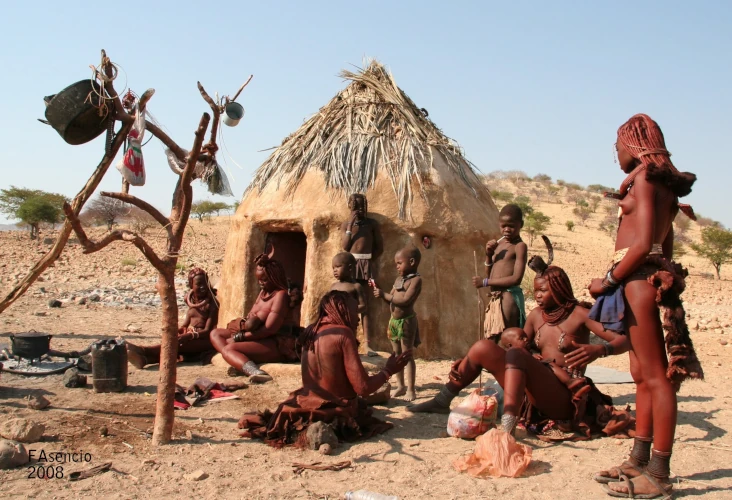
The Himba people are a semi-nomadic indigenous group that inhabits the Kunene region of northern Namibia, as well as southern Angola. They are known for their distinctive appearance, unique culture, and ongoing struggles to protect their land and way of life.
Appearance The Himba people are known for their distinctive appearance, which is characterized by their reddish-brown skin and intricate hairstyles. They use a mixture of ochre, butterfat, and herbs to coat their skin, which protects them from the harsh desert environment and gives them their distinctive color. Women wear elaborate hairstyles, often adorned with beads and cowrie shells.
Culture The Himba are a semi-nomadic people who rely on pastoralism and small-scale agriculture for their subsistence. They live in extended family groups and have a strong sense of community. Himba culture is known for its strong emphasis on gender roles, with men primarily responsible for herding and hunting, while women take care of the home and children.
Language The Himba language is a dialect of the Herero language and is spoken by approximately 50,000 people. It is a tonal language, with a complex system of vowel and consonant sounds.
Religion The Himba practice a traditional religion that is centered around ancestor worship and the belief in a supreme being called Mukuru. They also believe in the power of nature and the spirits of the natural world.
Population Size and Current Living Places The Himba population is estimated to be around 50,000 individuals, with the majority living in Namibia. They live in small, scattered villages throughout the Kunene region of northern Namibia and southern Angola.
Houses Himba houses, known as kraals, are made of a mixture of mud, cow dung, and grass. They are typically circular in shape and have a thatched roof. Each kraal is surrounded by a fence made of thorn branches to keep out wild animals.
Weapons The Himba traditionally used spears and bows and arrows for hunting and self-defense. However, with the influence of western culture, many Himba now also use guns.
Issues Faced The Himba face numerous challenges, including the encroachment of modern civilization on their land, conflicts with neighboring tribes, and the effects of climate change. The Himba are a traditionally patriarchal society, with village chiefs and elders playing an important role in decision-making.
Recent Contacts The Himba have had recent contacts with the outside world, which have brought both opportunities and challenges. Some Himba have been able to capitalize on tourism, while others have been negatively impacted by the encroachment of modern society on their land. The Himba continue to fight for their rights and to preserve their unique culture and way of life.
Korowai
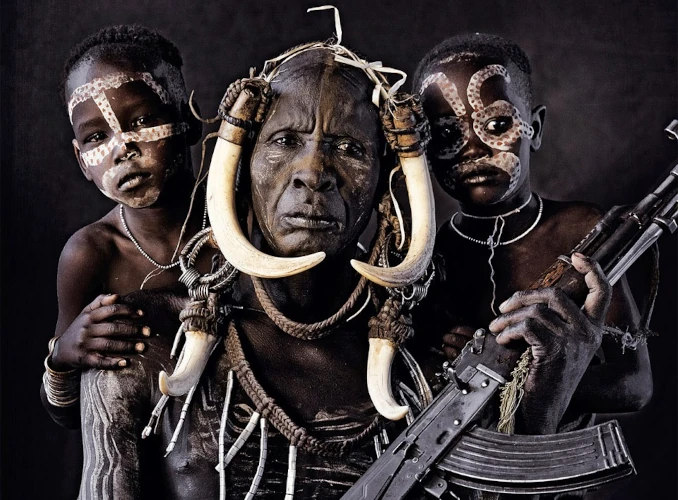
The Korowai people are a tribe of indigenous people who live in the southeastern part of Papua, Indonesia. They are known for their unique treehouse dwellings and their isolation from modern civilization.
Appearance The Korowai people are typically short in stature, with an average height of around 5 feet. They have dark skin and curly hair. Men traditionally wear loincloths made of bark, while women wear skirts made of sago leaves.
Culture The Korowai are a hunter-gatherer society and rely on the surrounding rainforest for their subsistence. They are known for their intricate treehouse dwellings, which are constructed high up in the canopy to protect them from flooding and dangerous animals.
Language The Korowai language is part of the Morehead-Maro family of languages and is spoken by approximately 3,000 people. It is a complex language, with a complex system of vowel and consonant sounds.
Religion The Korowai practice a traditional animistic religion, which centers around the belief that all things in the natural world have a spirit. They also believe in the power of ancestral spirits and use divination to communicate with them.
Population Size and Current Living Places The Korowai population is estimated to be around 3,000 individuals, with the majority living in small, scattered villages throughout the rainforest of southeastern Papua, Indonesia.
Houses The Korowai are known for their unique treehouse dwellings, which are built high up in the canopy of the rainforest. They are constructed using poles and branches and are connected to the ground by a series of ladders and ropes.
Weapons The Korowai traditionally used spears, bows and arrows, and blow darts for hunting and self-defense. They also use traps and snares to catch smaller game.
Issues Faced and Ruling Method The Korowai face numerous challenges, including the encroachment of modern civilization on their land, conflicts with neighboring tribes, and the effects of climate change. They have traditionally been ruled by village chiefs and elders, who make important decisions for the community.
Recent Contacts The Korowai have had limited contact with the outside world, with most interactions being with neighboring tribes and occasional visits from anthropologists and researchers. However, in recent years, there has been increased interest in the Korowai and their unique culture, which has led to increased tourism and development in the region. The Korowai continue to fight for their rights and to preserve their unique way of life.
Tsaatan
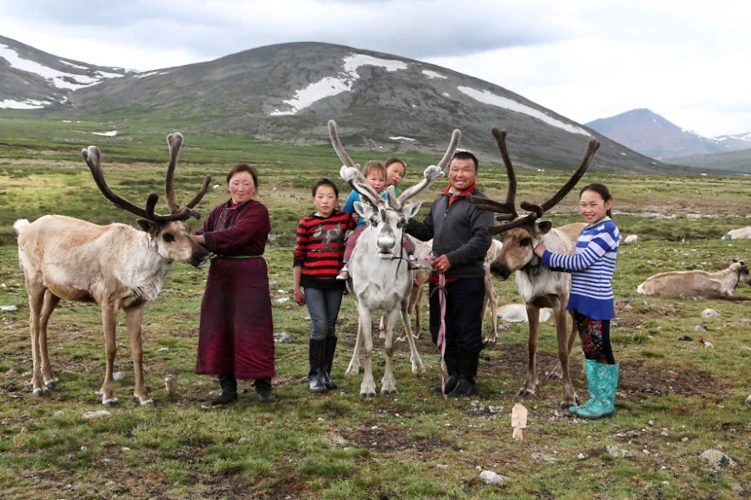
The Tsaatan people, also known as the Dukha people, are a small ethnic group of reindeer herders who live in the remote Taiga region of northern Mongolia and southern Siberia. They are known for their close relationship with nature and their unique way of life.
Appearance The Tsaatan people are typically short in stature, with an average height of around 5 feet. They have distinctive East Asian facial features, with high cheekbones and almond-shaped eyes. They often wear traditional clothing made of fur and leather to protect them from the cold climate.
Culture The Tsaatan people are nomadic and rely on their herds of reindeer for their subsistence. They are known for their unique style of reindeer herding, which involves using lassos and saddles made of reindeer skin. They also use the antlers and hides of the reindeer to make clothing and other items.
Language The Tsaatan language is part of the Mongolic language family and is spoken by approximately 400 people. It is a complex language, with many unique features that reflect the Tsaatan people’s close relationship with nature.
Religion The Tsaatan people practice a traditional animistic religion, which centers around the belief that all things in the natural world have a spirit. They also believe in the power of ancestral spirits and use shamanic rituals to communicate with them.
Population Size and Current Living Places The Tsaatan population is estimated to be around 400 individuals, with most living in small, scattered encampments throughout the Taiga region of northern Mongolia and southern Siberia.
Houses The Tsaatan people live in traditional teepee-like tents made of reindeer hides, which are easy to set up and take down as they move with their herds of reindeer.
Weapons The Tsaatan people traditionally used bows and arrows for hunting and self-defense. They also use knives and axes for various purposes, such as skinning animals and building their tents.
Recent Contacts The Tsaatan people have had limited contact with the outside world, with most interactions being with neighboring tribes and occasional visits from anthropologists and researchers. However, in recent years, there has been increased interest in the Tsaatan and their unique culture, which has led to increased tourism in the region. The Tsaatan continue to fight for their rights and to preserve their unique way of life amidst the pressures of modernization and environmental changes.